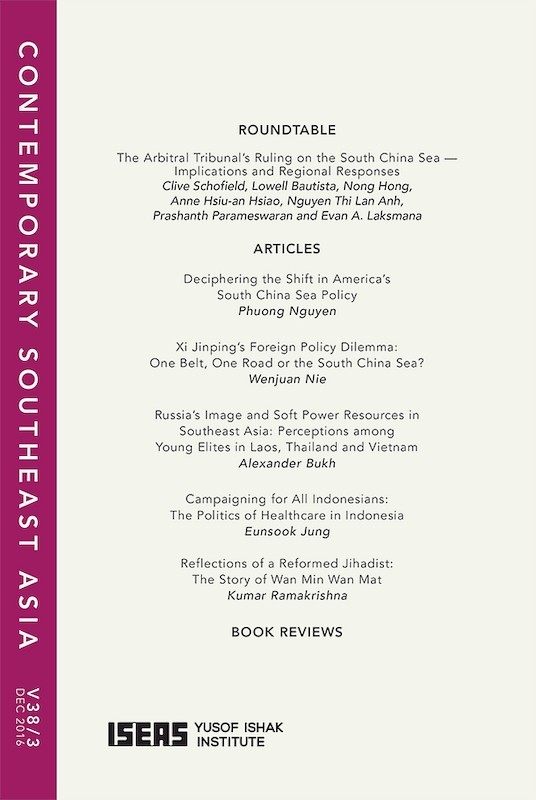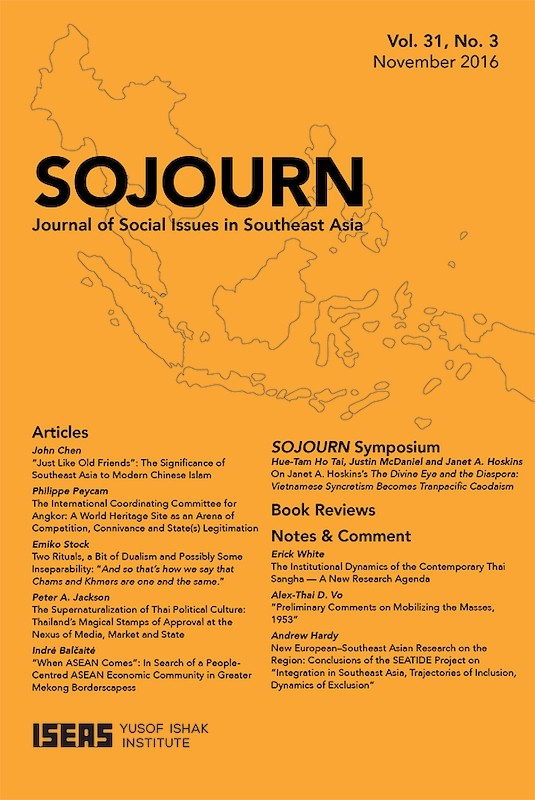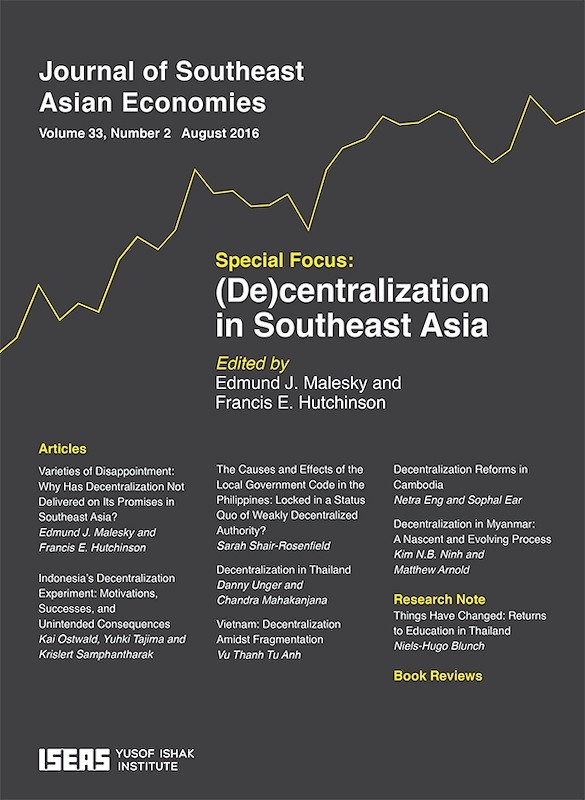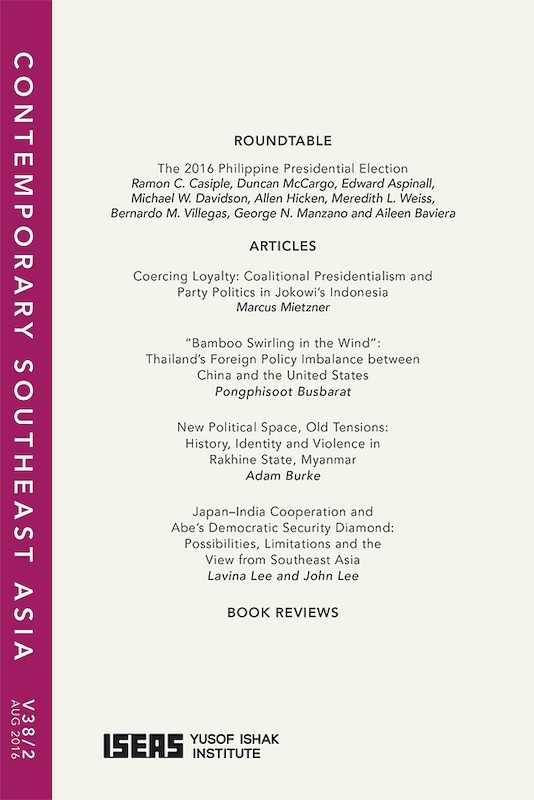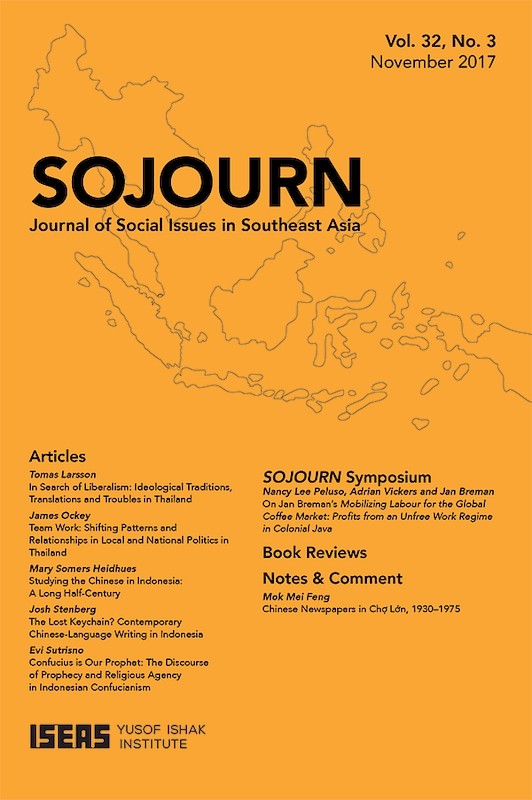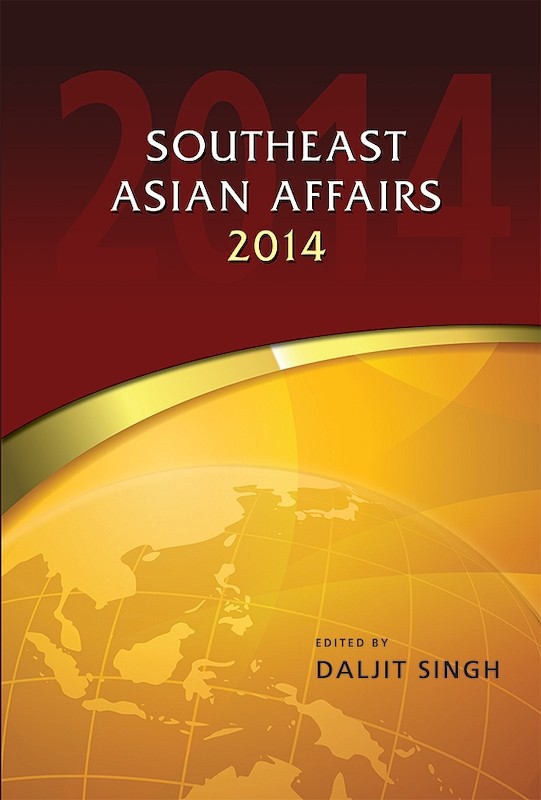Journal of Southeast Asian Economies Vol. 33/3 (Dec 2016).
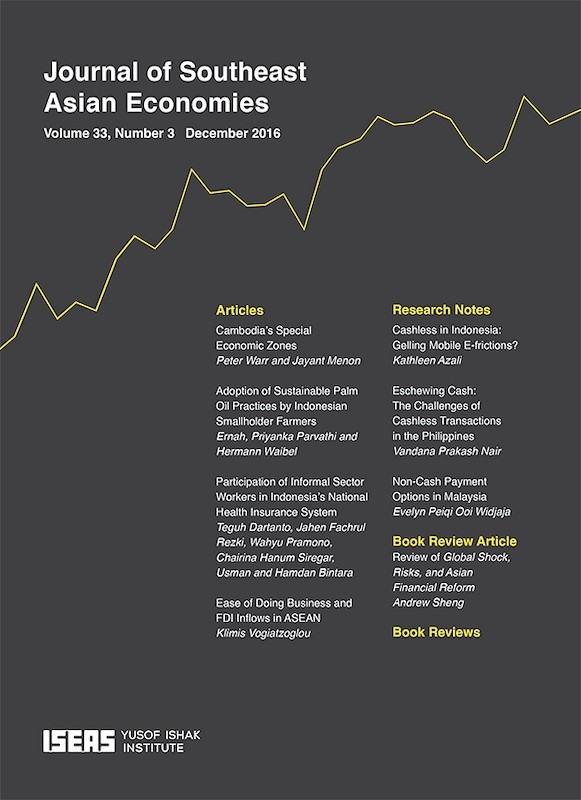
Date of publication:
December 2016
Publisher:
ISEAS - Yusof Ishak Institute
Number of pages:
162
Code:
AE33/3
Contents
-
Journal of Southeast Asian Economies Vol. 33/3 (Dec 2016).
[Whole Publication, ISSN: 23395206] -
Preliminary pages
- ARTICLES
-
1. Cambodia's Special Economic Zones, by Peter Warr, Jayant Menon, authors see abstract<div><font face="helvetica, arial, verdana, sans-serif"><span style="font-size: 13px;">This study asks whether Cambodia’s establishment of Special Economic Zones (SEZs) since </span></font><span style="font-size: 13px; font-family: helvetica, arial, verdana, sans-serif;">late 2005 has been successful, based on the evidence to date. SEZs have attracted significant </span><span style="font-size: 13px; font-family: helvetica, arial, verdana, sans-serif;">levels of foreign investment into the country that would not have been present otherwise, </span><span style="font-size: 13px; font-family: helvetica, arial, verdana, sans-serif;">creating around 68,000 jobs, with equal or better pay and better prospects than their </span><span style="font-size: 13px; font-family: helvetica, arial, verdana, sans-serif;">alternatives. A significant feature of the Cambodian experience is that the government has </span><span style="font-size: 13px; font-family: helvetica, arial, verdana, sans-serif;">left the establishment and management of the zones to private sector developers. The policy </span><span style="font-size: 13px; font-family: helvetica, arial, verdana, sans-serif;">measures needed to enhance the international competitiveness of the zones are similar to </span><span style="font-size: 13px; font-family: helvetica, arial, verdana, sans-serif;">those needed in the rest of the economy: infrastructure must be upgraded; trade facilitation </span><span style="font-size: 13px; font-family: helvetica, arial, verdana, sans-serif;">needs to be improved; electricity supplies must be made more reliable; corruption reduced </span><font face="helvetica, arial, verdana, sans-serif">and rules of payment to government agencies clarified; and labour quality must be upgraded </font>through investment in basic literacy and numeracy.</div>
-
2. Adoption of Sustainable Palm Oil Practices by Indonesian Smallholder Farmers, by Ernah, Priyanka Parvathi, Hermann Waibel, authors see abstract<div><font face="helvetica, arial, verdana, sans-serif"><span style="font-size: 13px;">The Indonesian Sustainable Palm Oil (ISPO) was introduced as a mandatory sustainability </span></font><span style="font-size: 13px; font-family: helvetica, arial, verdana, sans-serif;">standard for large oil palm producers in 2011. While these standards are voluntary for smallholder farmers, some of their crop management practices may converge with ISPO principles. Hence, this study investigates oil palm practices among smallholder farmers in Merangin district in Jambi province, Sumatra. We draw upon a three-year panel data set of 233 oil palm smallholder farmers. We assess the factors that explain the use of these practices first by means of a bivariate probit model for a sequence of practices defined as implementation thresholds. Second we apply a count model to examine the intensity of ISPO practices. Results show that the use of ISPO-type crop management practices is not widespread among oil palm smallholders. Sixty per cent of the farmers used four practices, and this share drops to 40 per cent for six practices. Among the factors that determine the use of practices were household characteristics, economic shocks and farmers’ perceived risk of diminishing oil palm productivity. This study provides a basis for developing an extension strategy of introducing ISPO practices for oil palm smallholders."</span></div>
-
3. Participation of Informal Sector Workers in Indonesia's National Health Insurance System, by Teguh Dartanto, Jahen Fachrul Rezki, Wahyu Pramono, Chairina Hanum Siregar, Usman, Hamdan Bintara, authors see abstract<div><font face="helvetica, arial, verdana, sans-serif"><span style="font-size: 13px;">The implementation of Indonesia’s national health insurance programme in 2014 highlights </span></font><span style="font-size: 13px; font-family: helvetica, arial, verdana, sans-serif;">the “missing middle” problem in which non-poor workers in the informal sector remain uncovered from the health care due to self-enrolment. This study aims at examining why informal workers are reluctant to join the national health insurance even though the benefits of the programme are very generous. Observing 400 households working in the informal sector and applying the Triple Bounded Dichotomies Choice Contingent Valuation Method to observe the Willingness to Pay, this study found that 70 per cent of respondents were willing to pay a premium that is lower than the current rate. Yet, only 18.7 per cent of households had registered for national health insurance. Our econometric estimations provide evidence that the availability of hospitals, insurance literacy, experiences of being an inpatient or outpatient, the number of family members, the sex of the head of the household, access to the Internet, and household income are highly correlated to the likelihood of workers in the informal sector joining the national health insurance programme. In contrast to other studies, we found that the insurance premium was not the primary impediment. Rather, the two main obstacles were: availability of health services; and a lack of insurance literacy. Hence, this study calls for increased investment on healthcare facilitates as well as campaigns to educate the public about the importance of health insurance.</span></div>
-
4. Ease of Doing Business and FDI Inflows in ASEAN, by Klimiis Vogiatzoglu, author see abstractThe paper first conducts an analysis of the patterns and trends in the business regulatory systems in ASEAN countries over time, which reveals the effectiveness of the regulations and the ease of doing business (EDB) across ASEAN. After sorting out the relevant business regulatory and control variables from a large set of measures, the determinants of intra-ASEAN and extra-ASEAN foreign direct investment (FDI) inflows are empirically examined. Particular consideration is given to the relative importance and effect of EDB measures on FDI attraction. Evidence is found that efficient business regulations are significant FDI determinants. Moreover, it is revealed that business regulatory efficiency is interrelated with other country attributes reflecting efficiency, sophistication, and quality. Overall, our study highlights the importance of business regulatory reforms in establishing an entrepreneurship-friendly environment and inducing increased FDI inflows in ASEAN countries.
- RESEARCH NOTES
-
Cashless in Indonesia: Gelling Mobile E-frictions?, by Kathleen Azali, author see abstractIndonesia has a large and diverse population, with highly uneven levels of development and a complex decentralized structure. This makes creating a long-term institutional framework and building connectivity infrastructure extremely challenging. The majority of the population is unbanked, and lacks access to fixed telephone lines or the country’s limited banking services. Cashless payment systems such as credit cards are used by less than 10 per cent of the population. The use of ATM and debit cards is still limited, although inter-bank transfers have increased after the introduction of a recent mechanism allowing inter-operability between different banks and mobile network operators. With the rapid growth of mobile uptake, mobile money has the potential to grow but comes with various constraints. This research note argues that in this highly dynamic and fragmented market, analysis and development of cashless payment needs to look beyond masterplan reports, to investigate the more informal, decentralized, mobile-led development and frictions in non-cash payments.
-
Eschewing Cash: The Challenges of Cashless Transactions in the Philippines, by Vandana Prakash Nair, author see abstract<div><font face="helvetica, arial, verdana, sans-serif"><span style="font-size: 13px;">Over the last decade, the Philippine government and private sector have spearheaded several </span></font><span style="font-size: 13px; font-family: helvetica, arial, verdana, sans-serif;">cashless initiatives in part to address the structural deficiencies of the country’s economy, such as its poor financial inclusion levels and its heavy reliance on remittances. This paper will provide an assessment of the non-cash payment industry in the Philippines. It will argue that while structural challenges have spurred the country’s most cutting-edge cashless initiatives, they have simultaneously impeded the full integration of cashless transactions into Philippine society. The Philippines will only achieve its goal to transition to a “cash-lite” country if the central bank, Bangko Sentral ng Pilipinas (BSP), and the private sector are able to coordinate efforts to address the financial system’s limitations.</span></div>
-
Non-Cash Payment Options in Malaysia, by Evelyn Peiqi Ooi Widjaja, author see abstractNon-cash payments such as payment cards as well as Internet and mobile banking are more efficient ways to complete transactions compared to cash. As such, the Malaysian government and the central bank, Bank Negara Malaysia, have embarked on a mission to bring Malaysia closer to becoming a cashless economy, which is in line with the country’s vision of becoming a developed nation by 2020. This research note aims to give a structured overview of the non-cash payment options, discuss the relevant policies that have been implemented since 2010, and the challenges that the country will face in adopting non-cash payment methods. The paper finds that the infrastructure which the government has been investing in to promote such payment methods that reflect the aims of the Financial Sector Blueprint 2011–2020 has met some level of success, but demand for non-cash payment instruments is lagging. To increase adoption, the central bank has to implement programmes to overcome the mindset of consumers, increase their trust towards non-cash payments and reduce their stickiness towards cash.
- BOOK REVIEW ARTICLE
-
Review of Global Shock, Risks, and Asian Financial Reform, by Andrew Sheng, author
- BOOK REVIEWS
-
BOOK REVIEW: Two Crises, Different Outcomes: East Asia and Global Finance, edited by T.J. Pempel and Keiichi Tsunekawa., by Malcolm Cook, author
-
BOOK REVIEW: Economic Change in Modern Indonesia, by Anne Booth, by Jamie S Davidson, author
-
BOOK REVIEW: Income Inequality in Singapore, by Pundarik Mukhopadhaya, by Evelyn Peiqi Ooi Widjaja, author
-
BOOK REVIEW: The Role of Public Bureaucracy in Policy Implementation in Five ASEAN Countries, edited by Jon S.T. Quah, by Tham Siew Yean, author
-
BOOK REVIEW: ASEAN Economic Cooperation and Integration: Progress, Challenges, and Future Directions, by Siow Yue Chia and Michael G. Plummer., by Archanun Kohpaiboon, author
-
BOOK REVIEW: The ASEAN Economic Community: A Conceptual Approach, by Jacques Pelkmans, by Bruno Jetin, author
-
BOOK REVIEW: The Asian Century, Sustainable Growth and Climate Change: Responsible Futures Matter, edited by Moazzem Hossain, Tapan Sarker and Malcolm McIntosh, by Veena Nair, author
-
BOOK REVIEW: Developing National Systems of Innovation: University-Industry Interactions in the Global South, by Eduardo Albuquerque, Wilson Suzigan, Glenda Kruss and Keun Lee, by J M Chandran, author
-
List of reviewers

